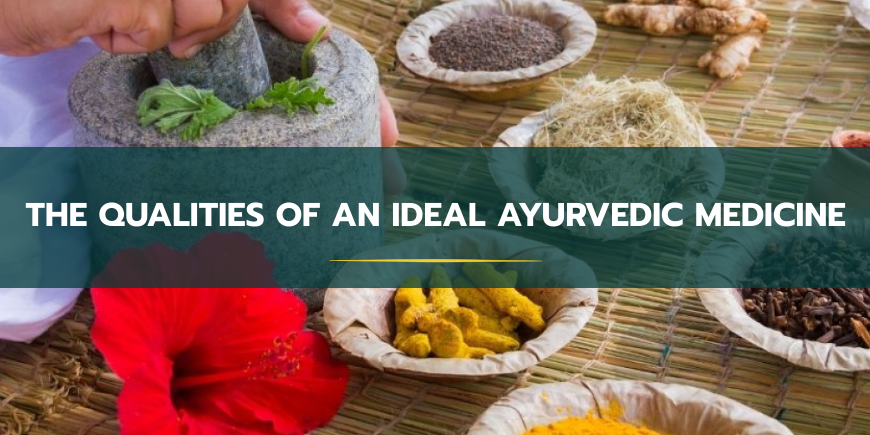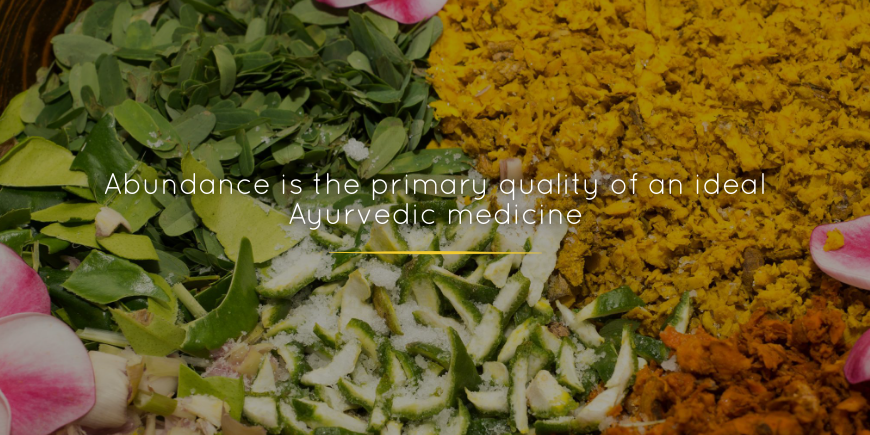
Introduction
Ayurveda offers an abundance of herbal options for each disorder. Moreover, Ayurveda lists a huge variety of health factors like body type, age, health condition, stamina, digestion, etc. The choice of the ideal medicine can vary drastically according to all these factors. Therefore, this wide range of healing options can be confusing.
Applicability and compatibility are the keys. For example –
- Turmeric is a great herb for wound healing. But there are better healing options like sandalwood for inflammatory disorders.
- Ashwagandha and Shatavari are great for overall vitality. But Ashwagandha is a better option for improvement in male fertility compared to Shatavari.
- On the other hand, Shatavari is a great herb for female reproductive health.
The choice is correct medicine is the foundation for personalized healing. Therefore, Acharya Charak defines the crucial qualities of an ideal medicine. These qualities help us to choose the most relevant herb for a particular health condition.
Qualities of an ideal medicine in Ayurveda according to Charak Samhita –
बहुता तत्रयोग्यत्वमनेकविधकल्पना| सम्पच्चेति चतुष्कोऽयं द्रव्याणां गुण उच्यते||७||
An ideal medicine should be easily available in abundance. It should have efficacy, the possibility of multiple pharmaceutical formulations, and natural qualities (full of bioactive ingredients).
Charak Samhita 9/7
Abundance
Abundance is the primary quality of an ideal Ayurvedic medicine. The medicine may be very good for a certain disorder or a particular patient. But, if it is inaccessible, then it is of no use to anyone. This is very practical advice in terms of treatment. Especially, emergency treatment requires instant availability of medicine.
Also, medicine should be available in ample quantity to ensure uniformity in the treatment procedure. Availability of medicine in small quantities may lead to inconsistent healing. That is why abundance is the key. But this abundance should be natural, not man-made.
Vocal for Local
In nature, native vegetation always has a dominant presence. However, today’s abundance can be a confusing factor, because of artificially created local availability of non-native herbs, fruits, and vegetables. For example –
- Kiwi is amply available in India. However, it is not a local fruit.
- Quinoa, a super grain from South America is available in good amounts in Europe.
- Indian herbs like Ashwagandha are available throughout the world.
The true essence of abundance lies in the availability of native produce. According to Ayurveda, the herbs, animals, and humans in a particular location are subject to specific climatic and soil conditions. They face similar weather cycles. Therefore, local herbs are naturally tuned to balance the homeostasis in the local climate.
Let us imagine the local vegetation to be a mother. The mother prepares warm clothes when winter approaches. And when it is summer, she puts away the warm clothes and hands out the umbrella and summer clothing. With the magic touch of mother nature, what we need naturally grows near us. She ensures that each zone has the most compatible set of herbs, useful for the local population. This is the reason why each climatic zone has distinct vegetation.
So, whatever grows near you is your healthiest option. For example –
- Saffron naturally grows in a cold climate and produces warmth in the body.
- Green cardamom naturally grows in a hot and humid climate and it helps to cool the body.
- Coconuts are almost always found near beaches, with a warm humid climate. They are the best options to restore the natural electrolyte balance in hot weather.
- Dates grow in dry, hot, and arid regions and they provide instant energy and coolness to the body.

Summary
Abundance is the first and foremost important factor for an ideal medicine. It ensures consistent treatment and complete healing. However, the true Ayurvedic abundance refers to naturally present vegetation; not imported produce.
Efficacy
The medicine should have qualities relevant to the current disorder. So, if you have two healing options in abundance, efficacy becomes the second most important factor. Let us try to understand this concept with simple food examples. For example –
Short Case Study
Common cold infection is a result of kapha dosha (cold) imbalance in the body. Fever is a result of imbalanced pitta dosha (hot).
you have a fever due to the common cold and you need a cooling herb. There are two anti-fever options available in abundance – Coconut water and green cardamom. (Both coconut and green cardamom grow in similar climatic conditions.)
Let us compare the efficacy of these options in the aforesaid health condition.
Coconut water
- Coconut water has a cooling effect on the body and increases kapha dosha.
- Therefore, coconut water is not the best solution for common cold-related fever, even if it is available in abundance.
Green cardamom
- Green cardamom has a cooling effect on the body. It also helps to control kapha related problems like cough, nausea, heaviness, etc.
- Therefore, green cardamom tea is a great option for common cold-related fever.
This is a simple example to elaborate on the concept of efficacy. Classical Ayurvedic medicines contain many herbs, minerals, metal ash, etc. Thanks to a variety of ingredients, these medicines have a multi-faceted effect on the body. Therefore, it is crucial to choose the drug with the right efficacy.
Seasonal Usage
This property also refers to differential seasonal usage. For example, an herb can be boiled to make tea during winter. The same herb can be soaked in water to make squash in summer.
This property is valuable as it increases the range of medicine usage in different seasons.
Multiple Usages
Another dimension of drug efficacy is multifaceted effects. Today, the patients do not have a single disorder. Normally, people come to a physician when the disorders become unbearable. At this stage, the disorder develops other complications or is coupled with other disorders. For example, we find that most obese people suffer from diabetes and hypertension.
In this case, a person may be taking many medicines. There is a possibility that one medicine may interact undesirably with the other. But what if a single medicinal preparation could address all the related disorders or their complications?
However, most of the classical medicines are prepared with a herbal combination that works for numerous disorders. For example,
Chandraprabha Vati, as a single drug is efficient for multiple disorders (UTI, kidney disorders, sexual disorders like syphilis, uterine disorders, general debility, nervine weakness, diabetes, liver disorders, and so on).
Mahanarayan Tailam is a classical Ayurvedic remedy used for vata disorders. You can consume it orally, perform body massage with it, use it for panchkarma therapies, and so on. Therefore, one single preparation can target a wide range of disorders when used in different ways.
There are many such examples in terms of classical Ayurvedic medicines.
Summary
The medicine should have an overall balancing effect on the dosha. The overall balancing outcome and zero side effects define the efficacy of a medicine.
Multiple Preparations
The word “Anek Vidh Kalpana” means an option for varied preparations. This is a very special property that enables the multifaceted usage of a herb/medicine.
Depictions of Goddess Durga show eight hands with different weapons. She is so completely prepared for battle that she carries myriad weapons. So, in all possible war situations, she has a suitable option. “Anek Vidh Kalpana” refers to a fully armed herb, a herb that can be used in multiple ways.
For example –
Turmeric is an herb with excellent anti-oxidant, anti-aging, anti-inflammatory, anti-microbial and rejuvenating properties. Possible Kalpana or preparations of turmeric are –
Turmeric tea
best for kapha problems
immunity booster, good for obesity, heaviness, skin disorders
Turmeric milk
Best for pitta disorders
Rejuvenating, great for the weak, for children, elderly, recuperating, people without teeth
Turmeric Powder
Used in multiple food preparations – fried rice, poha, Indian curries, kadi, pickles, etc. Food with turmeric has natural immune-boosting properties.
Turmeric is used in both sweet and savory dishes. For example, both sweet Pongal and masala rice use turmeric.
Therefore, turmeric is a natural health supplement that is with long shelf life, easy storage, and adds extra flavor and fragrance to a wide variety of dishes.
Turmeric serves both preventive and curative purposes by adding immune-modulatory properties to the food. It is one of the best examples of “Anek Vidh Kalpana” or multiple usages.
Summary
If an herb can transform itself into “Anek Vidh Kalpana” or multiple preparations, it offers a wide range of usage possibilities. It can serve in different health conditions, age groups, climatic conditions, and so on.
A Prosperous Herb
The Sanskrit word “sampan” means prosperous. In an Ayurvedic context, it means – a herb/medicine brimming with its natural bioactive ingredients. Such a herb is full of medicinal properties and well equipped to cure the disorder.
Let us compare this well-resourced herb to a soldier. A soldier can fight under all circumstances. However, he can fight best when he is well-equipped with a gun, armor, bullets, etc. Similarly, a cook can make tasty food when he is well-equipped with the necessary ingredients and cooking gear. Similarly, a sampan herb is full of medicinal juice that helps to cure the disorder.
Seasonal Produce
Anything that grows naturally, in the appropriate season is full of bioactive ingredients. Such herbs have superlative nutrition and medicinal properties compared to herbs that grow in unnatural climates and soil. Therefore, Ayurveda recommends local and seasonal herbs to ensure that you get the best medicinal essence from these herbs.
Non-seasonal Produce and Dosha Balance
On the other hand, Ayurveda strictly prohibits the use of non-seasonal produce. Acharya Charak says that one should not eat produce grown in unnatural soil, climate, eaten by insects, and devoid of its natural form, taste, or aroma. The plants that grow in unnatural climatic conditions or soil naturally do not have natural nutrition. But they can also be detrimental or toxic to health!
The body has a dosha cycle. Each naturally seasonal grown plant helps to balance the dosha cycle in the body. But non-seasonal plants disturb the dosha balance instead of balancing it.
For example –
Cauliflower naturally grows in winter. It increases vata dosha in the body. However, in winter all doshas are naturally balanced and therefore cauliflower does not bring any harm to the body.
However, Ayurveda prohibits the use of vegetables, esp. cauliflower, green peas, cabbages, etc. During the rainy season. Also, these vegetables naturally do not grow in the rainy season.
The rainy season brings a cyclic vata imbalance. Consuming cauliflower during the rainy season can cause or aggravate severe vata disorders like body pain, joint pain, arthritis, autoimmune disorders, etc.
Therefore, it is a health hazard to consume non-seasonal cauliflower during the rainy season.
Ayurveda against GMO
Normally, non-seasonal vegetation cannot survive in odd climatic conditions, but for human intervention.
Genetically modified crops emerged in the 80s and spread throughout the globe. These crops were supposed to have better yields, greater resistance to pests, etc. Also, these crops are designed to grow in unnatural climatic conditions. And here is the catch!
These crops are good for shelves in the store, not for the human body. Since they have an unnatural genetic constitution, the body labels them as dangerous foreign substances. As a result, the body attacks these GM foods in the form of food allergies.
Therefore, genetically modified food is a strict no-no in an ideal Ayurvedic diet.
More is not always better
Today, we have herbs with more percentage of bioactive ingredients. For example, scientists identified withanolides as the bioactive ingredients in Ashwagandha. Normal Ashwagandha powder contains 2.5% of withanolides. However, today we have abnormally concentrated Ashwagandha preparations that may have 10% or more percentage of withanolides. But more is not always better.
According to modern science, more concentration of bioactive ingredients may lead to more possibility of absorption inside the body. However, in most cases, this approach has backfired.
The true healing potential of an herb is not dependent only on a few scientifically identified bio-active ingredients. Many other compounds support the functions of the primary bioactive ingredients. All constituents in an herb work in synergy to produce the healing effect. That’s why, when we jeopardize the natural composition of the herb, we also disturb its healing potential.
And this is the reason many naturally harmless herbs produce side effects. Kava Kava has been used for thousands of years in Oceania for multiple disorders. Its natural preparations never had any side effects or complications on the natives. However, scientists prepared highly concentrated extracts of Kava Kava, and it produced severe side effects like hepatotoxicity.
Take Away
Acharya Charak lists four properties of an ideal medicine. An ideal medicine should be easily available in abundance. Besides, Ayurveda advocates the use of naturally available native herbs.
An efficient medicine should have the relevant properties to treat the disorders, without any side effects or complications. Also, it should be available in multiple Ayurvedic pharmaceutical preparations. For example – decoction, capsule, powder, etc. A medicine blessed with all the above properties ensures the best results irrespective of other treatment factors.
The sampan herb is the one that grows naturally and is harvested when it is juiciest, in its natural season of growth. This herb has a maximum level of bioactive ingredients naturally possible. Besides, these bioactive ingredients are well supported by other compounds.
Ayurveda rejects non-seasonal produce. Therefore, genetically modified crops are not healthy as per Ayurveda. They lack their natural genetic composition and hence their natural properties.
The bottom line is – whatever is naturally available is the best for us.
I hope that this blog helps you to make the best treatment choices.
Are you ready to explore the ancient healing system of Ayurveda? Our Ayurveda Certification Course offers a comprehensive understanding of this time-tested practice. From learning the fundamentals to advanced techniques, you’ll gain the knowledge and skills to promote optimal health and well-being. Join us on this transformative journey and become a certified.

Responses